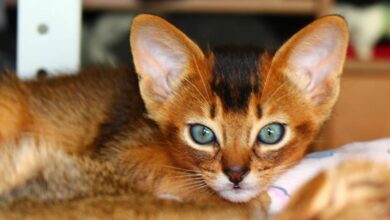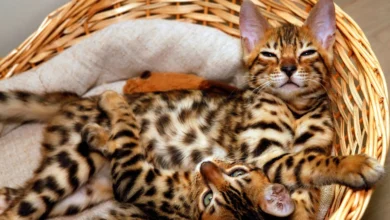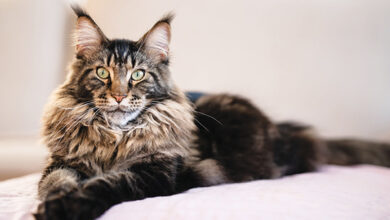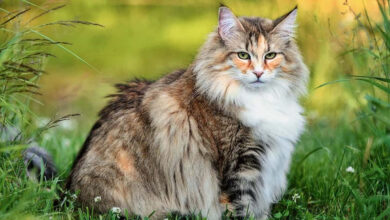A Comprehensive Guide: Ragdoll Cats
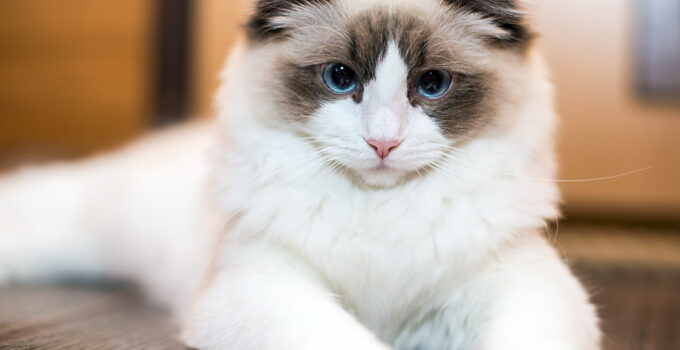
Frequently Asked Questions about Ragdoll Cats
What do ragdoll cats eat?
As an indoor cat breed, ragdolls do best on premium quality dry or wet cat food that meets their nutritional needs. Look for brands formulated for large and senior cats to provide ample calories. Most cat lovers feed ragdolls twice daily and avoid table scraps which can promote obesity in their stocky frame. Fresh drinking water should always be available.
Is a ragdoll a lazy cat?
While ragdolls are known for their very calm and relaxed demeanor, it would be inaccurate to call them outright lazy. Instead, their chilled temperament makes them ideal home companions for busy families. Ragdolls are reasonably active indoors but not high energy. They enjoy playtime, treats, grooming, and paying attention to their terms rather than being hyper. Their nature suits sedentary owners best.
Why are ragdolls so expensive?
Several factors contribute to ragdolls commanding higher prices than average cats. Strict genetic breeding programs aim to preserve their distinct characteristics. Health screening tests ragdoll lineages for issues. Individual breeders may focus on champion bloodlines, rare coat colors, show potentials or hand-raising litters. Their renowned personality type has solid demand worldwide too. Overall, the specialized selective breeding behind pedigree ragdolls justifies the premium price tag over moggies.
What’s so special about ragdoll cats?
At the heart of the ragdoll’s appeal lays their remarkable gentle temperament. As one of the most docile, affectionate, and easygoing cat breeds, ragdolls thrive as family pets, therapy cats, and even performers due to tolerating handling. Their bond with owners and ability to easily train makes them highly suitable pets. Appearance-wise, ragdolls stand out in terms of size, colorpoint coats, and “ragdoll” loose muscles that are relaxing when held. Good health and placid nature along with their unique qualities have cemented ragdolls as sought-after cat companions.
Why is it called a ragdoll cat?
The name stems from the amusing physical reaction ragdolls exhibit when picked up – their loose, floppy limbs look akin to how a rag doll would drop limply. In the 1960s, when the breed was founded, the lax body type that was cuddled was said to have inspired the name. As selective breeding progressed, ragdolls retained a reputation for relaxing in their owner’s arms or laps, appearing like ragdolls themselves. While their name is not related to the toy, it perfectly captures their signature trait bringing joy to their admirers.
Introduction
Ragdoll cats are one of the most popular cat breeds worldwide due to their gentle and affectionate nature. As one of the largest domestic cat breeds, they have become increasingly popular pets in Australian homes. However, their calm demeanor and large size mean they are not suitable for every household.
How to identify a Ragdoll cat
Ragdoll cats have very distinct physical features that make them easy to identify. Their large size and physical attributes, like their colorpoint coat pattern, are dead giveaways. Some key identifying characteristics of ragdoll cats include:
- Colorpoint coat – Ragdolls have a colorpoint coat where the points of their limbs, face, and tail are darker in color than the rest of their body. The points will darken with age.
- Blue eyes – Ragdolls usually have light blue eyes, though eye color can vary slightly by coat color.
- Large size – Males can weigh over 10 pounds as adults, with females slightly smaller. They have a stocky and muscular build.
- Loose skin – Ragdolls are known for their loose skin that seems to “go limp” when picked up, giving them a ragdoll-like appearance. Their skin has extra folds that make hand-carrying them very easy.
- Gentle temperament – Even as kittens, ragdolls tend to be calm, relaxed, and friendly with everyone compared to other cat breeds.
These unique physical characteristics and temperament make ragdoll cats very recognizable once you know what to look for. Their docile nature makes them a favorite show cat as well.
Ragdoll Cat Breeds
There are six recognized breeds of ragdoll cats, distinguished mainly by their coat coloring:
- Blue: A blue-gray color with darker blue points.
- Lilac: A pale lavender coat with slightly darker lavender points.
- Chocolate: A tan-brown coat with richer chocolate points.
- Seal: A dark brown coat with black points.
- Flame (Red): A red-orange coat with cream points. Often called the rarest color.
- Natural: A true cream or beige coat with pale cream points. Also quite rare.
All ragdoll breeds share the same basic characteristics, but their coloring is what sets them apart. Breeders aim to follow strict breeding standards to maintain the distinct traits of each color variety.
Ragdoll Cat Personality
Ragdolls are renowned for their affectionate, gentle, and relaxed personalities. Due to selective breeding, ragdolls naturally display characteristics that make them suitable as pets:
- Affectionate – Ragdolls bond strongly with their owners and insist on daily affection like petting. They’ll greet you at the door.
- Calm – They are among the most docile cat breeds and unlikely to scratch or bite even when stressed. Easy to handle as lap cats.
- Social – Friendly not just with people but also tend to get along well with other pets in the home.
- Laid-back – Enjoy napping and won’t demand much activity from busy owners. Low energy indoors.
- Trainable – Due to their easygoing nature, ragdolls can learn commands and tricks with positive reinforcement.
- Vocal – Ragdolls are chatty and use various meows, purrs, and other sounds to communicate.
It’s this gentle, loving, and agreeable personality that has made ragdolls immensely popular household pets and companions.
Black Ragdoll Cat
Among the ragdoll cat breeds, black ragdolls hold a special appeal for many. Their ebony fur with dark gray or slate blue points gives them a striking yet elegant look. Despite the black color, temperamentally, they are no different than other ragdoll breeds:
- Coat – Glossy black fur has slight blue undertones and a charcoal hue at the points of limbs & tail.
- Eyes – Black ragdolls usually have brilliant sapphire or deep ocean blue eyes.
- Color standards – Breeders aim to maintain dark, evenly distributed color over the whole coat with no brown or light shades.
- Health – No greater disease risks than other ragdolls due to their breeding lineage. Remain vigilant for common cat illnesses.
- Care – Identical grooming and care needs as other coated ragdolls. Weekly brushing prevents mats and tangles.
So, for pet owners who want jet black beauty with the classic ragdoll temperament, breeders worldwide now focus on producing quality black ragdolls. Their striking dark fur makes quite the fashionable house cat.
Ragdoll Cat Size
As one of the largest domesticated cat breeds, ragdolls are substantial in size yet retain an elegant stature. On average:
- Male weight: 10-12 lbs fully grown
- Female weight: 8-10 lbs
Compared to the average housecat size of 5-10 lbs, ragdolls stand out as larger and heavier-boned cats. While individual size can vary, healthy weights remain within:
- Male ideal range: 9-15 lbs
- Female ideal range: 7-12 lbs
In addition to weight, linear measurements for ragdolls are:
- Body length: 15-20 inches
- Height at shoulder: 10-15 inches
Their barrel-chested wide frame houses substantial muscle and bone structure befitting their stature. Despite the larger heft, ragdolls stay remarkably agile and gentle. Size alone shouldn’t deter potential owners – their affectionate nature wins many pet lovers over. Just be mindful of providing adequate space and consideration in small homes.
Ragdoll Cat Price
Given the popularity and specialized breeding behind ragdoll cats, their price tag is significantly higher than average moggies or mixed breed cats. In Australia, expect to pay:
- Non-pedigreed ragdoll or rescue: $200-800
- Pedigreed pet quality ragdoll: $1000-2000
- Champion pedigree show quality: $2000-5000
- High-end rare colors: $3000-10,000
Breeders charge premiums based on several factors:
- Pedigree/genetics – Multi-gen pedigree adds value, popularity of lineage.
- Color/pattern rarity – Unique, rare colors command the highest prices.
- Health testing – Breeders who test for genetic issues get higher prices.
- Quality – Conformation to breed standards, show potential affects cost.
- Age – Kittens younger than five months cost the most due to hand-raising needs.
While undeniably pricey, devoted ragdoll owners find their affectionate nature worth the investment. Adopting rescues also provides the breed with benefits at a lower upfront cost.
Difference between a Ragdoll Cat and a Regular Cat
While both make wonderful pets, ragdoll cats have several notable distinctions from mixed breed or regular domestic shorthair cats:
- Size – Ragdolls are substantially larger as one of the biggest cat breeds.
- Color/pattern – Recognizable pedigree colors and points not seen in moggies.
- Coat – Ragdolls have medium-length, wooly coats needing regular brushing.
- Temperament – Renowned to be gentle, calm, and affectionate even as kittens.
- Conformation – Stocky, muscular frame following breed type standards.
- Origins – Pedigree lineage tightly supervised by breeders versus random domestic ancestry.
- Price – Pedigreed ragdolls significantly cost more than moggies from shelters.
- Training – More trainable than average cats due to diligent breeding for handling.
While regular cats make good pets, too, ragdolls offer consistent, predictable temperament qualities sought after by many owners. Just know their needs may differ.
Smallest Breed of Ragdoll
Among the recognized ragdoll cat breeds, the natural variety can produce the smallest specimens on average. Details on the smallest ragdoll:
- Coat color – True cream or beige coat with pale creamy points.
- Size – Weight range may overlap 6-10 lbs for females. Slightly stockier bone structure than the average ragdoll.
- Growth – Kittens are born comparatively petite, remaining smaller as adults.
- Appeal – Sought after due to appealing petite stature yet retaining ragdoll charm.
- Production – Naturals remain quite rare, comprising under 5% of ragdoll litters worldwide. Price reflects scarcity.
- Care – No unique size-related needs apart from smaller portions of food and toys. Remain active indoors.
So, the natural ragdoll presents an option for those wanting a ragdoll’s affectionate nature in a smaller package that is suitable even for smaller homes. Their charming miniature stature retains all the beloved ragdoll personality traits.
Conclusion
Ragdoll cats have gained widespread popularity around the globe, especially in Australia, due to their affectionate, gentle disposition and eye-catching looks. While large in size, ragdolls remain sprightly indoor companions for both families and individual owners. Their calm demeanor makes them highly suitable pets ideally suited to calm lifestyles over active homes. For those wishing to provide a ragdoll with its specialized needs, the rewards of their charming personalities are immense and certain to yield years of enjoyment. With the right care and research beforehand, ragdolls prove wonderful lifelong feline family members.
